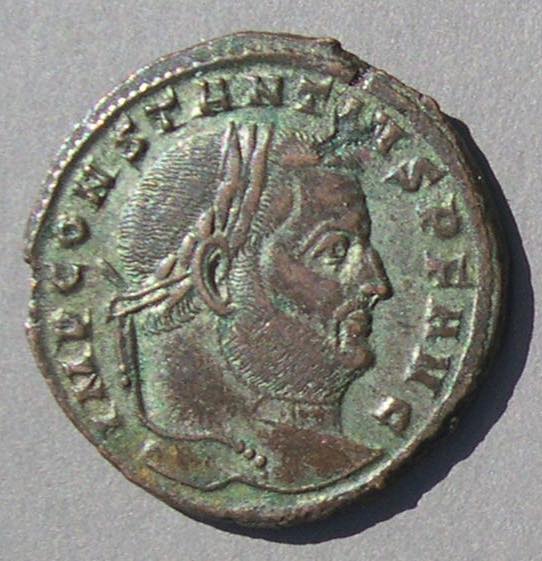
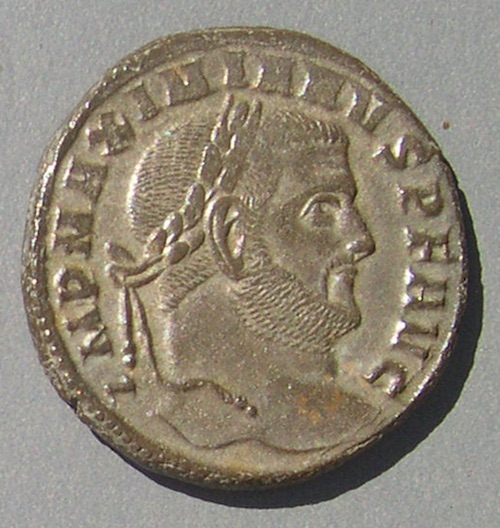
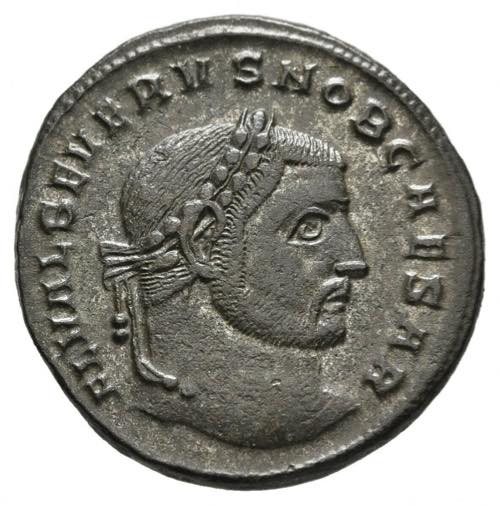

(To go to those coins, click on the images)
 |
 |
| Constantius, western Augustus | Galerius, eastern Augustus |
 |
 |
| Severus II, western Caesar | Maximinus II, eastern Caesar |
| The Second Tetrarchy (To go to those coins, click on the images) |
|
Roman Coins of the Second Tetrarchy, 305-306 CE
The Second Tetrarchy: History. The Augusti (emperors) of the First Tetrarchy, Diocletian and Maximian, retired on May 1, 305. The Caesars Constantius and Galerius of the First Tetrarchy became the new Augusti and the title on their coins changed from Caesar to Augustus. New Caesars, Severus II and Maximinus II, were appointed, which began the "Second Tetrarchy" ("four rulers"). It ended with the death of Constantius in July 306. The Second Tetrarchy is defined by the reign of Constantius as Augustus.
The "Second Tetrarchy," May 1, 305 - July 306:
• Augusti: Constantius (in the west) and Galerius (in the east)
• Casears: Severus II (in the west) and Maximinus II (in the east)
• Diocletian and Maximian retired "senior" Augusti
Coins were issued for all six rulers. The coins for the retired augusti are discussed at the page "Abdication coins of Roman emperors Diocletian and Maximian." (Here is a page on coins of the First Tetrarchy.)
What's new? 2020, March 20: Galerius HERCVLI VICTORI.
The Second Tetrarchy: Coins. The reign of Constantius as Augustus defines the Second Tetrarchy. His three co-rulers outlived him and after his death the complications introduced by the elevation of his son Constantine in July, and the usurpation of Maximian's son Maxentius in October ended the tetrarchal system.
Denominations issued include the:
• follis, by far the most common denomination (below)
• post-reform radiate, only at Alexandria and rare (below)
• quarter-follis, only at Siscia (below and on its own page)
• rare so-called "fractions" mostly from Trier, but a few from other mints (below and on their own page)
• silver argenteus, rare and soon to be discontinued (below and on its own page)
• gold aureus, rare and very expensive (Gold will not be discussed further on this page)
Sections below:
• The next coins on this page are the new types of folles.
• Then there is a short survey of the other denominations (with links to pages about them).
• Then the types of folles continued from the First Tetrarchy are listed and discussed.
• A few more folles of types previously discussed.
• History: The beginning of the Second Tetrarchy. After the end of the Second Tetrarchy.
Another page covers
• Dating coins. A page on how coins are attributed to the time of the Second Tetrarchy.
Folles. There were 14 active mints. Some minted only the previous GENIO POPVLI ROMANI type from the First Tetrarchy and others issued new types. A list of mints and the types they issued is far below. Retirement types for Diocletian and Maximian are not included because they have their own page).
New types listed (and illustrated below. Types continued from the First Tetrarchy are further below):
• Four new types with FIDES MILITVM, only for the Augusti Constantius and Galerius (Here)
FIDES MILITVM, Fides seated left with standard in each hand, at Ticinum and Aquileia (Here)
FIDES MILITVM, Fides standing left with standard in each hand, at Ticinum (Here)
FIDES MILITVM AVGG ET CAESS NN, Fides seated with a standard in each hand, at Aquileia (Here)
FIDES MILITVM AVGG ET CAESS NN, Fides standing with a standard in each hand, at Aquileia (Here)
• Three new types with VIRTVS (Here)
VIRTVS AVGG ET CAESS NN, Mars advancing right with spear and trophy over shoulder, only for the Caesars Severus II and Maximinus II. (Here) [later for Constantine as Caesar at Ticinum] (Here)
VIRTVS AVGG ET CAESS NN, Prince standing left with captive at feet left, holding small Victory and spear and shield, only for the Caesars and only at Aquileia [later for Constantine as Caesar at Ticinum] (not illustrated)
VIRTVS AVGG ET CAESS NN, horseman riding right, spearing a foe, for all four rulers at Aquileia (Here) [and later for Constantine as Caesar and Severus II as Augustus]
• PERPETVITAS AVGG, Roma seated left, helmeted, only for Severus II at Alexandria. (Here)
• Two very similar Concordia types
CONCORD IMPERII, Concordia standing front, only for Maximinus II at Alexandria. (Here)
CONCORDIA IMPERII, Concordia standing front, only for three Caesars, Severus II, Maximinus II, and Constantine, at Siscia. (Here)
FIDES MILITVM. There are four new types with FIDES MILITVM issued for the new Augusti, Constantius and Galerius, but not for the Caesars, at Ticinum and Aquileia.
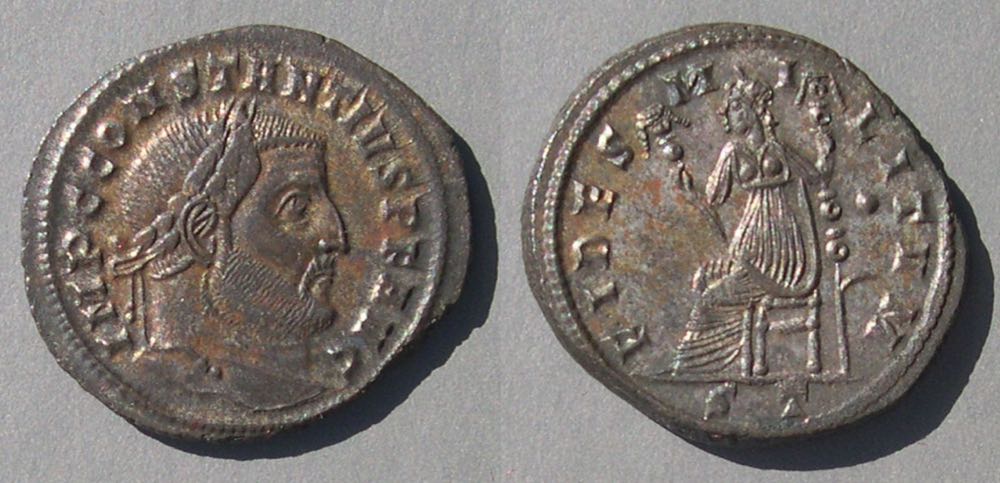
Constantius as Augustus
28 mm. 10.38 grams.
IMP C CONSTANTIVS PF AVG
Laureate head right
FIDES MILITVM
Fides seated left holding standard in each hand.
S T in exergue.
RIC Ticinum 55a "c. 305".
Fides types were issued only for the Augusti and only at Ticinum and Aquileia.
(An example for Galerius)
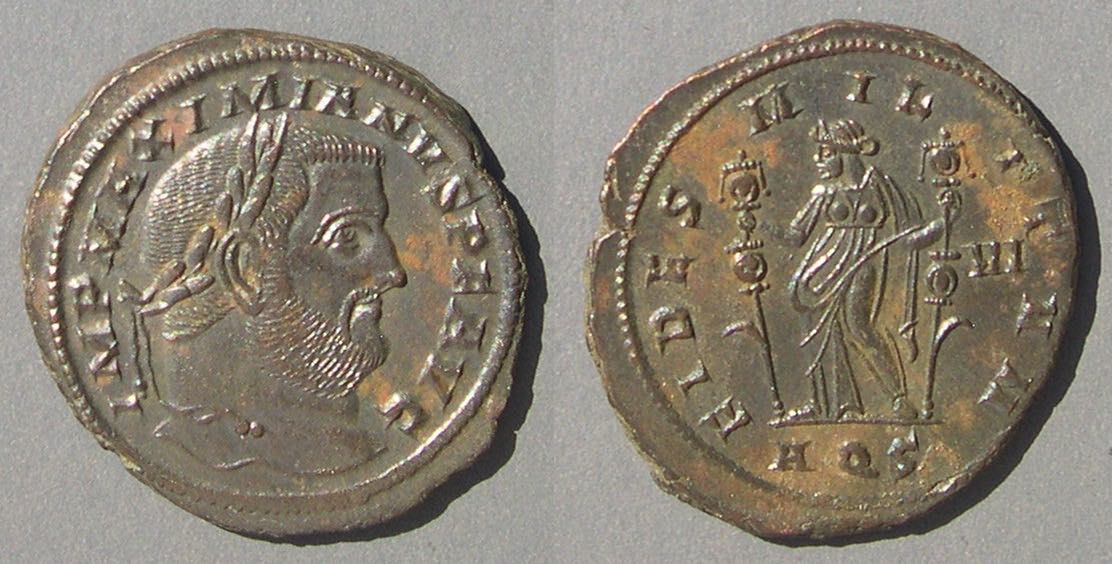 Galerius as Augustus
Galerius as Augustus
29 mm. 10.21 grams.
IMP MAXIMIANVS PF AVG
Laureate head right
FIDES MILITVM, Fides standing left with standard in each hand
VI in right field, AQS in exergue.
RIC Aquileia unlisted but would be 56b "c. 305".
Note: The obverse legend includes "MAXIMIANVS" but the coin is of Galerius, not Maximian. The portrait lacks the distinctive upturned nose of Maximian and the co-ruler in this issue is Constantius as Augustus. There is a page on how to distinguish the ruler we call Galerius from Maximian.
Notes about this page:
• Almost all folles are like the first two in that they have "Laureate head right." Descriptions of obverse portraits below are omitted unless they are different.
• The essential reference is RIC (Roman Imperial Coinage) volume VI by C. H. V. Sutherland, 1973. Many varieties have been discovered since RIC VI was written, but there is still no better way to get both an overview and details of the coinage.
Constantius as Augustus
29-27 mm. 8.73 grams.
IMP CONSTANTIVS PF AVG
FIDES MILITVM AVGG ET CAESS NN
Fides seated left holding standard in each hand
AQS
RIC Aquileia 62a
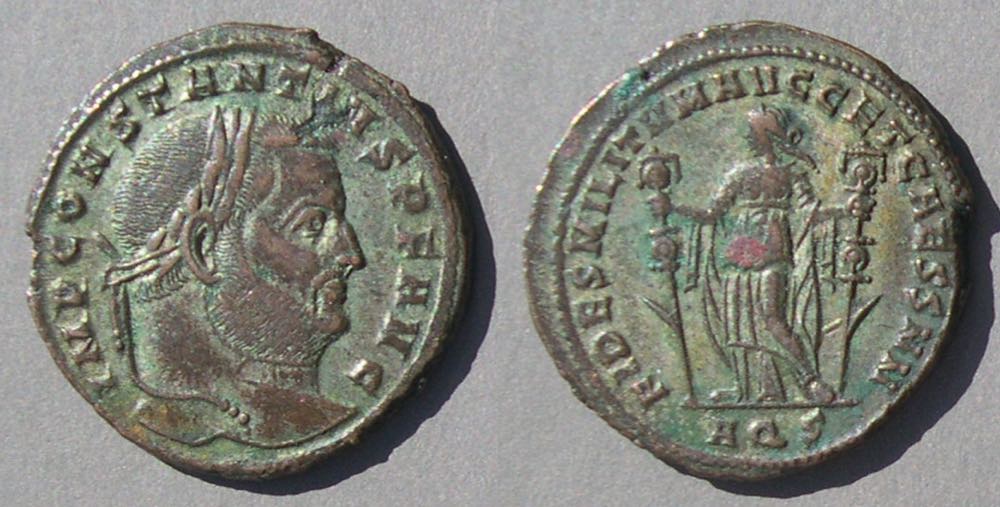
Constantius as Augustus
28 mm. 8.84 grams.
IMP CONSTANTIVS PF AVG
FIDES MILITVM AVGG ET CAESS NN
Fides standing left holding standard in each hand
AQS
RIC Aquileia 60a
(This type for Galerius)
Virtus. The Caesars did not participate in the Fides issues from Ticinum and Aquileia. They had types with Virtus. The personification of Virtus is virtually identical with Mars, so the figure walking may be Virtus but is often called Mars.

Severus II as Caesar
26-25 mm. 7.92 grams.
SEVERVS NOB CAESAR
VIRTVS AVGG ET CAESS NN, Mars advancing right with spear in right hand and holding trophy over his left shoulder.
PT in exergue.
RIC Ticinum 60a, "c. 306."
This type was also issued for Maximinus II, but not the Augusti.
The most striking new design has both an unusual helmeted head left and a horseman riding right.
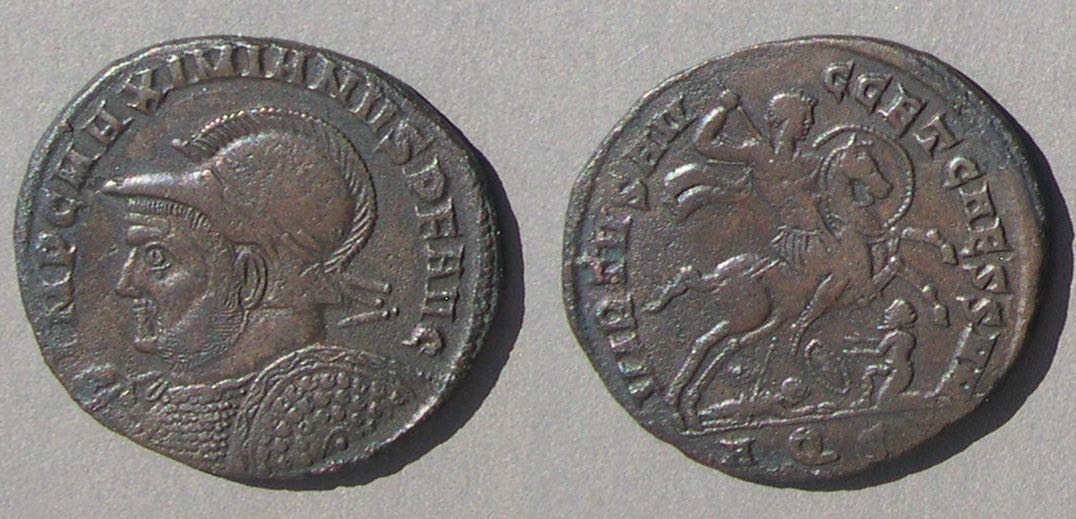 Galerius as Augustus
Galerius as Augustus
28-25 mm. 8.24 grams.
IMP C MAXIMIANVS PF AVG
Bust in crested helmet left, holding scepter over far shoulder and shield in left.
VIRTVS AVGG ET CAESS NN
Horseman (emperor) galloping right, shield on left, spearing kneeling foe with dropped shield, prostrate foe below.
AQS in exergue
RIC Aquileia 81a "25 July 306-c. March 307."
[This type began under the Second Tetrarchy, but this particular example is from after Constantine was added to the type. The only difference is in the obverse legend. This one has "IMP C" and the earlier one has just "IMP".]
PERPETVITAS AVGG at Alexandria. At Alexandria, each ruler had his own type. This type was for Severus II.
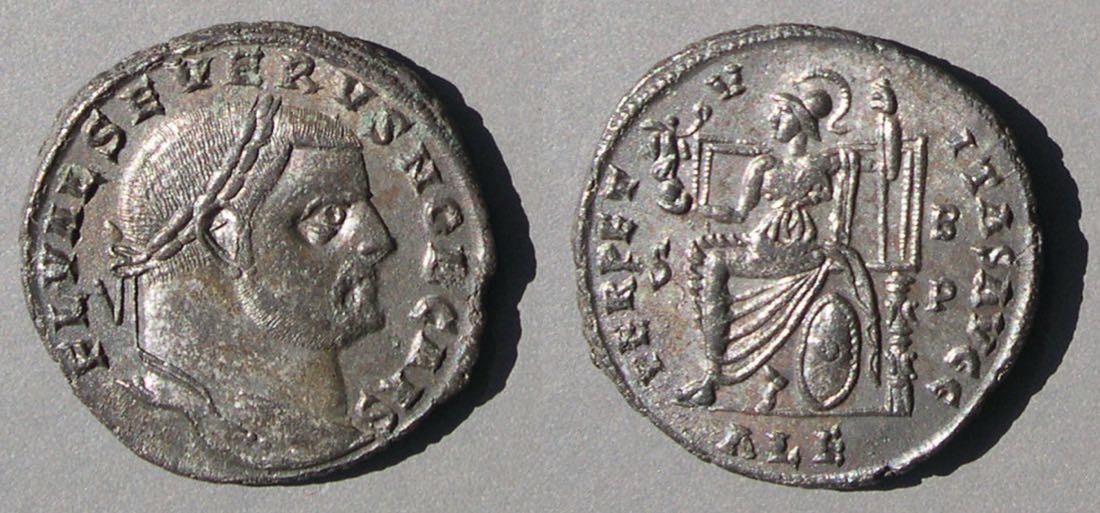
Concordia. There are two very similar types with Concordia.
CONCORD IMPERII at Alexandria, for Maximinus II only (next coin), and
CONCORD-IA IMPERI at Siscia, for Maximianus II, Severus II, and also Constantine as Caesar.
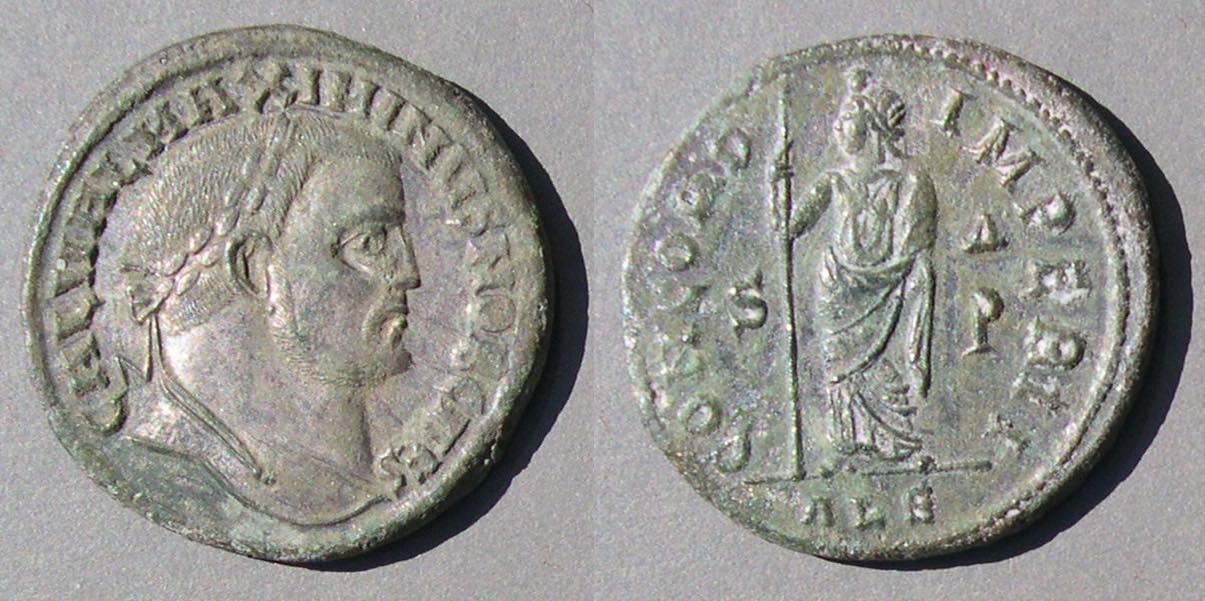
Maximinus II as Caesar.
28 mm. Surface-silvered.
GAL VAL MAXIMINVS NOB CAES
(GALerius VALerius MAXIMINVS NOBle CAESar)
CONCORD IMPERII
Concordia standing front, head left, right holding long scepter, left holding cross-fold of drapery
Δ
S P
ALE in exergue
RIC Alexandria 52 "305-306".
At Alexandria each of the four rulers had only his own type. Severus II had PERPETVITAS AVGG (above). Constantius had HERCVLI VICTORI and Galerius had IOVI CONS CAES--types which were continued from the First Tetrarchy.

Maximinus II as Caesar
27 mm.
MAXIMINVS NOB CAES
CONCORD-IA IMPERII
VI
SISB in exergue
RIC Siscia 174b variety (officina B. Only Γ is listed.)
It is not certain this coin was issued during the Second Tetrarchy, even though the issue includes Severus II as Caesar. Read a page on assigning dates of issues.
Follis types that were continued from the First Tetrarchy are below, after the other denominations of the period.
Other denominations. Other denominations include
• post-reform radiate (next below)
• quarter-follis, only at Siscia (below and on its own page)
• rare so-called "fractions" mostly from Trier, but a few from Rome (below and on its own page)
• argenteus, rare and soon to be discontinued (below and on its own page)
Post-Reform Radiate. The post-reform radiate (a.k.a. "radiate fraction") denomination was introduced in the reform of c. 294 and, although it is common, it was only issued at a few mints and never became a major part of the coinage system. It is not certain how the reform pegged its values of the denominations. Some authors think these new radiates were 2 denarii and five of these made one follis of 10 denarii (prior to Diocletian's Edict of Maximum prices). Where did the old aurelianus fit in? I think it was also pegged at 2 denarii which explains seven things. The new radiate
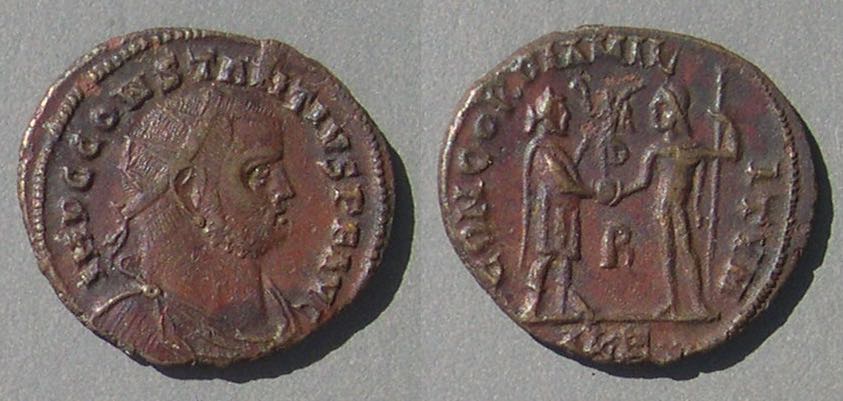
Constantius as Augustus.
21-19 mm. 3.12 grams.
IMP CONSTANTIVS PF AVG
Radiate, draped, and cuirassed bust right
CONCORDIA MILITVM
R in middle field
ALE in exergue
RIC Alexandria 59aB.
All four rulers participated in this issue and it was continued for Severus II as Augustus and Constantine as Caesar. (A page about radiate fractions.)
Quarter-follis. The quarter-follis denomination was issued only at Siscia at the beginning of the Second Tetrarchy. Before the 1990's, it was rare in the west because it had circulated in the region near Siscia which was behind the Iron Curtain. Now, it is far more common than the rarity ratings in RIC have it. It was issued for all four tetrarchs plus Maximian as Augustus. How Maximian fits in with the other four with Second Tetrarchy titles remains unexplained.

Constantius as Augustus
19 mm. 2.34 grams. That is much smaller than the 28 mm follis and about 1/4 the weight.
CONSTANTIVS AVG
GENIO POPVLI ROMANI
RIC Siscia 169a "R2," but actually much more common than that.
There is a page devoted to quarter folles. It is not known why Siscia issued this smaller denomination with the old GENIO POPVLI ROMANI design and why they did not issue the full-size follis of this design when so many other mints did.
Fractions. For some unknown reason a few fractional denominations were issued c. 290-321, mostly at Trier, which celebrated anniversaries with small issues of small laureate coins which expressed vows. We follow Zschucke in calling them "fractions." (These are not the larger so-called "quarter follis" coins of Siscia above). A few are from Rome, Lyon, Ticinum, and Siscia. Zschucke lists 263 fractional varieties from Trier. We do not know the ancient names of these small denominations, nor are we certain how they relate to the other denominations of Diocletian's coin reform of c. 294, the "follis" or "nummis," the post-reform radiates, and the silver argenteus. Zschucke calls them "1/8 [follis]" (the smaller ones) and "1/4" (the larger ones) with a few later ones under Constantine called "1/2." Unusual small coins like these were issued in the names of emperors Diocletian through Crispus and Constantine II.
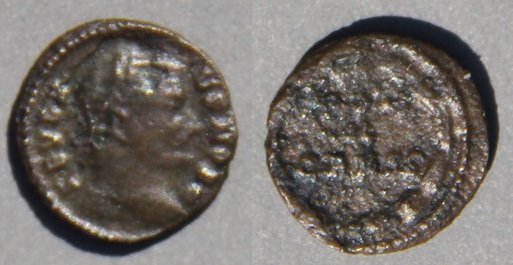 This coin marks the promotion of Severus II to Caesar.
This coin marks the promotion of Severus II to Caesar.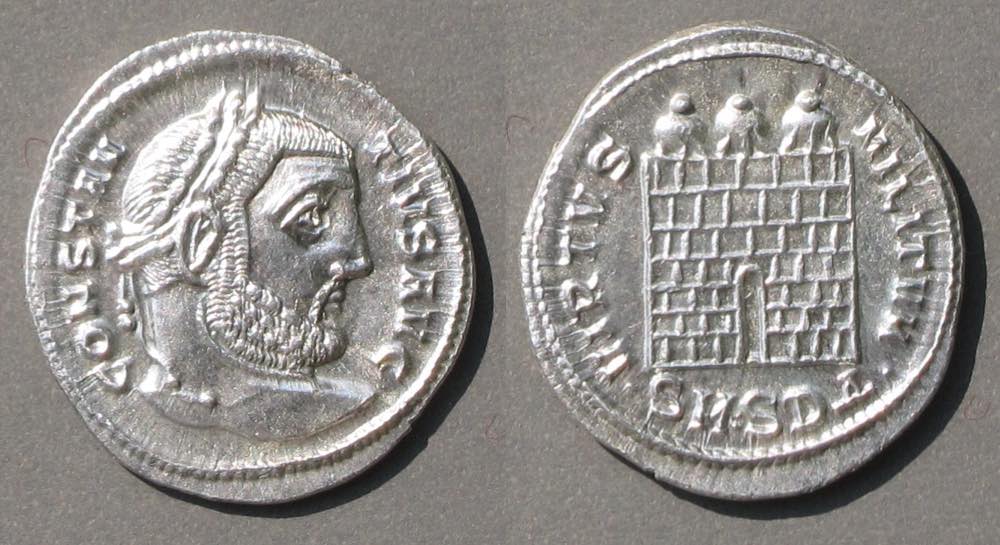
(For much more about argentei, see the page on argentei.)
GENIO AVGG ET CAESARVM NN at Cyzicus. This type (ending CAESS NN) had been issued for the Caesars of the First Tetrarchy at Cyzicus (Here). It continued for the Caesars of the Second Tetrarchy--only the Caesars and only at Cyzicus.
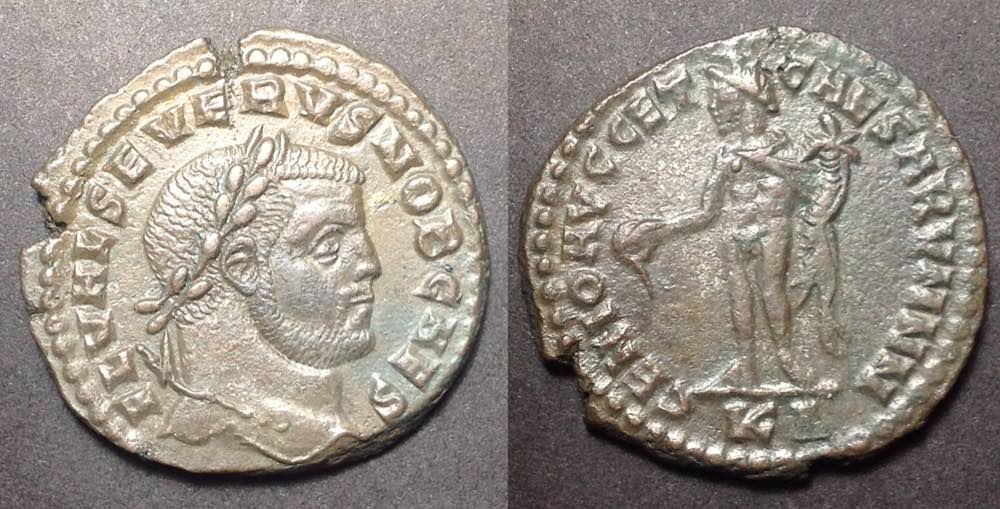
Severus II as Caesar
FL VAL SEVERVS NOB CAES
GENIO AVGG ET CAESARVM NN, Genius standing left with patera and cornucopia
KΔ in exergue
RIC Cyzicus 20a. "305-306"
Carthage. Carthage issued only one type and that type was issued only at Carthage. It was continued from the First Tetrarchy and issued for all four rulers.
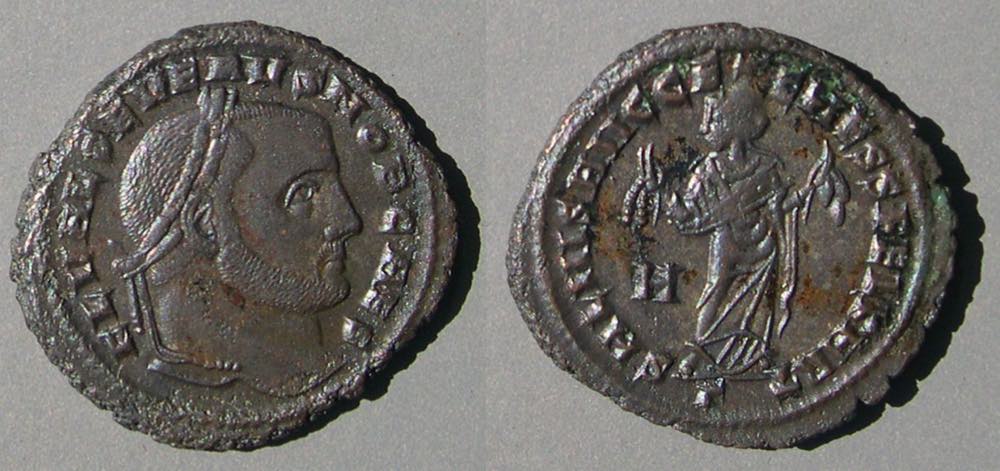
Severus II as Caesar
28 mm.
FL VAL SEVERVS NOB CAES
SALVIS AVGG ET CAESS FEL KART
Carthage standing holding out fruits in each hand
H in field left, Γ in exergue.
RIC Carthage 40a.
(An example for Maximinus II)
Alexandria. Under the Second Tetrarchy Alexandria issued HERCVLI VICTORI for the western Augustus and IOVI CONS CAES for the eastern Augustus, but not for the Caesars. Under the First Tetrarchy HERCVLI VICTORI had been issued both for the western Augustus and Caesar and IOVI CONS CAES for both the eastern Augustus and Caesar. Also, the HERCVLI VICTORI type was issued at Siscia under the Second Tetrarchy.
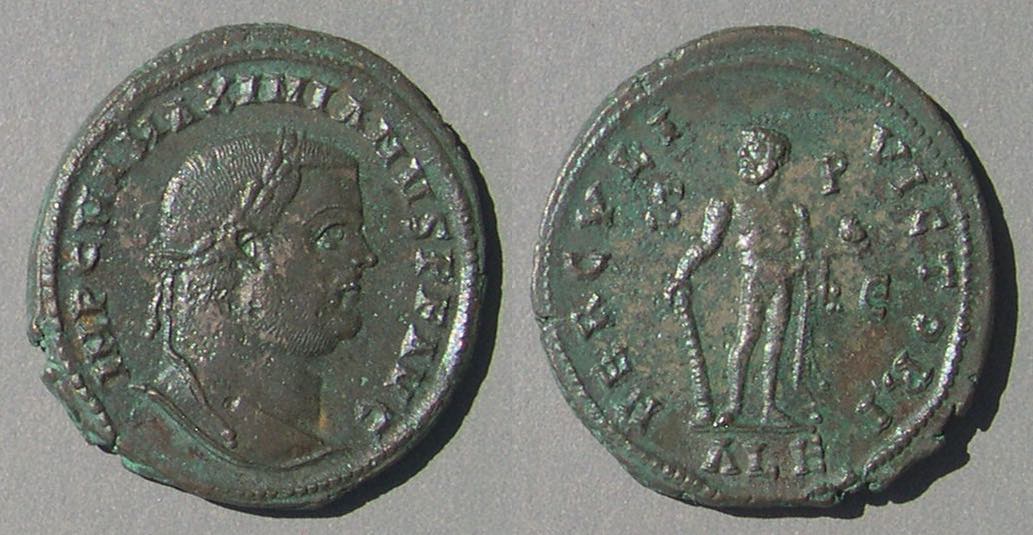 [This example is of Maximian as Augustus under the First Tetrarchy, but is of the type issued for Constantius as Augustus under the Second Tetrarchy.]
[This example is of Maximian as Augustus under the First Tetrarchy, but is of the type issued for Constantius as Augustus under the Second Tetrarchy.]

![]() [This example is of Galerius as Caesar under the First Tetrarchy, but is of the same type issued for Galerius as Augustus under the Second Tetrarchy.]
[This example is of Galerius as Caesar under the First Tetrarchy, but is of the same type issued for Galerius as Augustus under the Second Tetrarchy.]
Galerius during the First Tetrarchy.
26 mm. 9.04 grams.
GAL VAL MAXIMIANVS NOB CAES
IOVI CONS CAESS
Jupiter standing holding Victory on globe, and scepter
B
S P
ALE in exergue
RIC Alexandria 43
The obverse legend for Galerius as Augustus is
IMP C MAXIMIANVS PF AVG (in perfect parallel with the legend of Constantius).
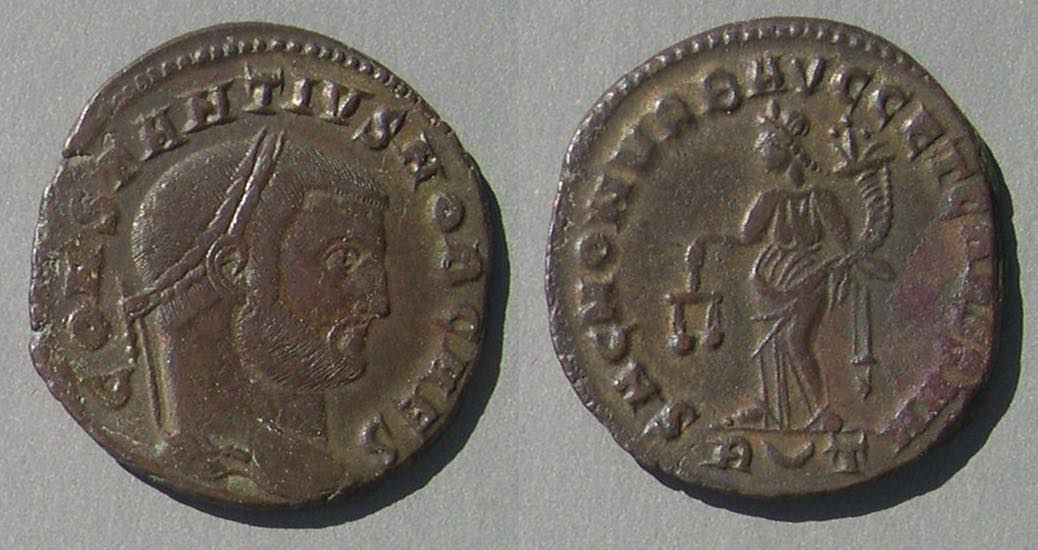 [This coin is from Rome with Constantius as Caesar, not as Augustus. But at least it shows the reverse type.]
[This coin is from Rome with Constantius as Caesar, not as Augustus. But at least it shows the reverse type.]
 [This coin is of Galerius as Caesar under the First Tetrarchy, but it has the reverse type used at Siscia under the Second Tetrarchy, with a reverse legend variant (NOSTR for NN).]
[This coin is of Galerius as Caesar under the First Tetrarchy, but it has the reverse type used at Siscia under the Second Tetrarchy, with a reverse legend variant (NOSTR for NN).]
Galerius during the First Tetrarchy
26 mm. 9.24 grams.
MAXIMIANVS NOB CAES
SACRA MONET AVG ET CAESS NOSTR
V
AQΓ in exergue
RIC Aquileia 32b "c. 301"
The Galerius as Augustus type at Siscia has obverse legend
IMP C MAXIMIANVS AVG.
GENIO POPVLI ROMANI. By far the most common follis type is GENIO POVPLI ROMANI. It was very common under the First Tetrarchy and continued to be common during the Second Tetrarchy. Examples from the time of the Second Tetrarchy are next and many more examples from under the First Tetrachy can be seen on their own pages.
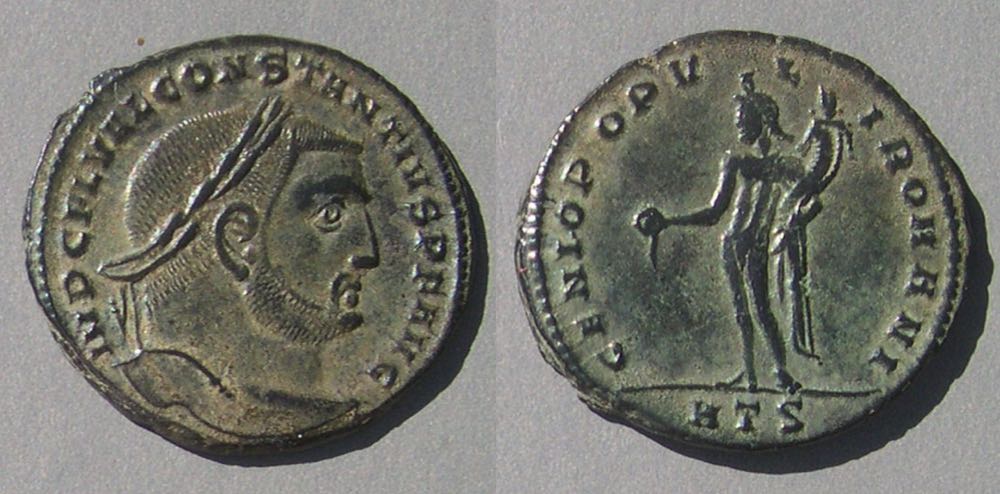
Constantius as Augustus
27-25 mm. 8.76 grams.
IMP C FL VAL CONSTANTIVS PF AVG
GENIO POPVLI ROMANI, Genius standing left, head with tower, naked but for chlamys over left shoulder, holding patera and cornucopia.
HTS in exergue.
RIC Heraclea 24a "1 May 305-25 July 306" (i.e. as Augustus).
That type was issued for all four rulers and continued after the end of the Second Tetrarchy.

Galerius as Augustus.
27 mm. 9.42 grams. Much surface-silvering.
IMP C GAL VAL MAXIMIANVS PF AVG
(IMPerator Caesar GALerius VALerius MAXIMIANVS Pius Felix AVGustus)
GENIO POPVLI ROMANI
Є in right field. •SM•SD in exergue, for "Sacra Moneta, SerDica."
RIC VI Serdica 12b.
The coins of Severus II as Caesar are from the Second Tetrarchy, or just a short while longer. According to the tetrarchal system the Caesar was promoted when the position of Augustus became vacant. Severus II was Caesar in the west and was duly promoted after the death of the western Augustus, Constantius. However, there may have been a time lag before Severus II was acknowledged Augustus while Galerius, the eastern Augustus, gave his advice and consent.
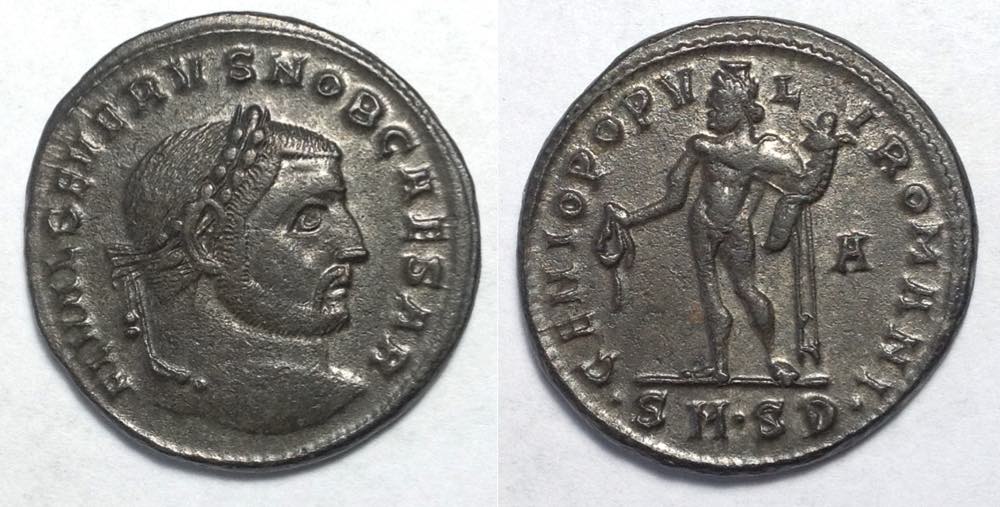
Severus II as Caesar
27 mm. 9.54 grams.
FL VAL SEVERVS NOB CAESAR
(FLavius VALerius SEVERVS NOble CAESAR)
GENIO POPVLI ROMANI
A in right field. •SM•SD• in exergue.
RIC VI Serdica 13a, "1 May 305 - 25 July 306."
At Trier there was an issue for the four rulers with Genius naked (not illustrated here for Trier, but the coins above show the type) as had been the only depiction of Genius since the design's inception in 294, followed by an issue with loins draped that included Constantine as Caesar. Differences like these affect dating. The next two coins are from that "loins draped" issue which is discussed in detail on this page about dating.

Severus II as Caesar
27 mm.
FL VAL SEVERVS NOB C
Bust right, laureate and cuirassed.
GENIO POPVLI ROMANI, Genius standing left, head with tower, loins draped, holding patera and cornucopia, S in left field, F in right field. (That might abbreviate "Saeculi Felicitas"--happy times.)
PTR in exergue
RIC Trier 651 "1 May 305 - early 307"
Maximinus II was Caesar from May 305 until early 309 when he became Augustus, so his coins as Caesar may or may not be issued during the Second Tetrarchy.
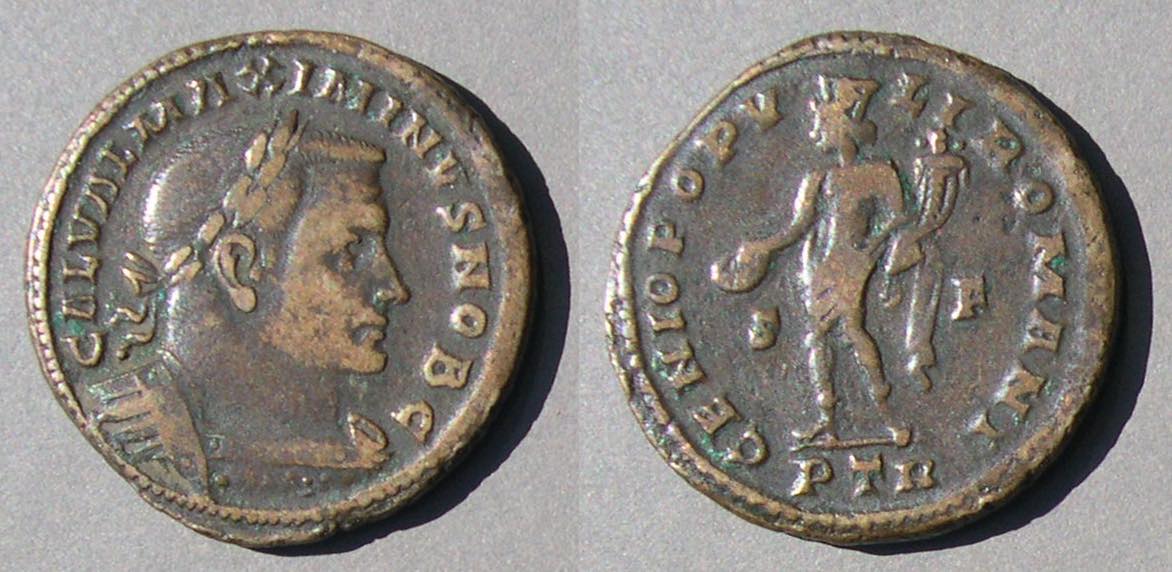
Maximinus II as Caesar
27 mm.
GAL VAL MAXIMINVS NOB C
Bust right, laureate and cuirassed.
GENIO POPVLI ROMANI, Genius standing left, head with tower, loins draped, holding patera and cornucopia.
S in left field, F in right field. (That might abbreviate "Saeculi Felicitas"--happy times.)
PTR in exergue
RIC Trier 667b "1 May 305 - early 307"
These control marks and mintmark are used on an issue at Trier where Genius is naked and only the four rulers participate. This coin with "loins draped" is from a second part of that time period in which five rulers, including Constantine participate. Maybe the elevation of Constantine was enough to change the presentation of Genius and this type is later than the Second Tetrarchy. Or, maybe the issue was in progress when Constantine was elevated and he joined it late.
Mints of the Second Tetrarchy and their follis types. "GPR" abbreviates "GENIO POPVLI ROMANI for all four tetrarchs." This list does not include retirement types for Diocletian and Maximian.
History: The beginning of the Second Tetrarchy.
Constantius added Spain to his territory of Gaul and Britain. Severus II got Africa, Italy, and Pannonia (taken away from Galerius). Galerius got all of Asia Minor (which had been part of Diocletians' territory) west of the Tarsus mountains, which increased his base significantly. Maximinus II got Syria and Egypt.
When Diocletian decide to retire he had to select new caesars. However, he had been seriously ill for over a year and not as strong a personality as he had been. Maximian had an eligble son, Maxentius, and Constantius had an eligible son, Constantine. But Galerius, also in the east, had his own candidates. Somehow it was decided that Maxentius was unsuitable and that it would not work to appoint Constantine and not Maxentius. So Galerius got his way with both new caesars being his choices.
The end of the Second Tetrarchy. The "Second Tetrarchy" only lasted until Constantius died in July 306. At that time his son Constantine was promoted without the advice and consent of the other rulers, either by the dying Augustus Constantius or by the army after his death. The orderly system that had created the Second Tetrarchy lasted less than two years. In short summary, after Constantius died in July 306:
• Constantine was acclaimed emperor by the army when Constantius died in July 306, or by Constantius as he was dying
• Severus II was elevated to Augustus in the west by Galerius (the remaining, eastern, Augustus). There may be some time lapse because there are issues (at Trier and Siscia) with both Severus and Constantine as Caesars. (Discussed on the page about dating)
• Maxentius, son of Maximian, seized power in Rome in October 306 when Severus was away in the north
• Maximian came out of retirement to join him in November, and resumed the title Augustus and began his "second reign"
• both Maxentius (early[?] 307) and Constantine (July 307) took the title Augustus (There are issues with Maxentius as Augustus and Constantine as Caesar) and
• Severus II was killed in the summer of 307 after failing to retake his territory which included the city of Rome.
Each of these events is reflected in the coinage. There is a page on coins after the Second Tetrarchy, from 306-324. There is also a long page on the events that lead Galerius to award the title FIL AVG to Constantine and Maximinus II during 309-310.
A few more examples. An example of each follis type of the Second Tetrarchy is given above. Next are a few more examples.
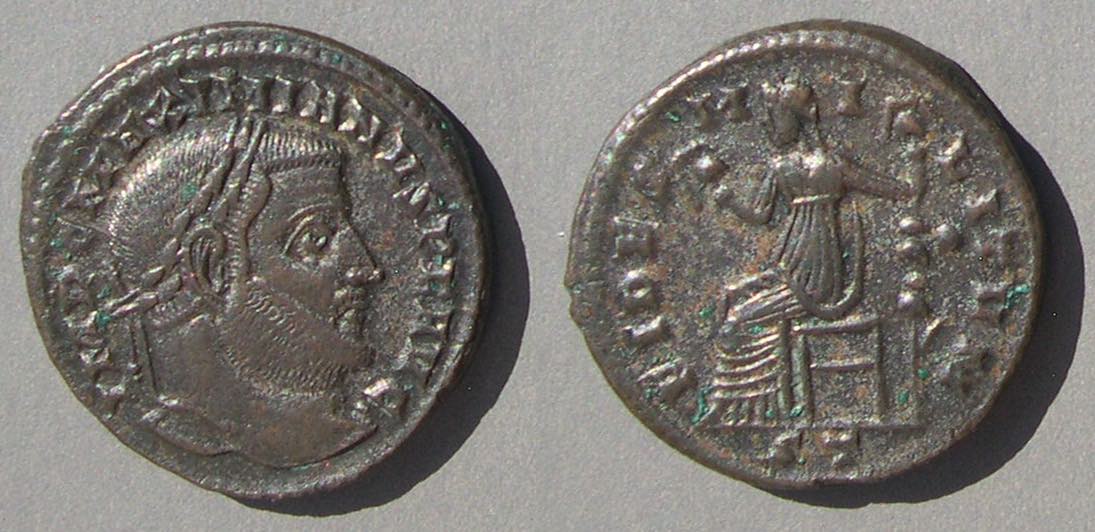
Galerius as Augustus
27 mm. 11.83 grams.
IMP C MAXIMIANVS PF AVG
FIDES MILITVM
• in right field
ST in exergue
RIC Ticinum 55b "1 May 305 - July 306"
(This type for Constantius)

Galerius as Augustus
27 mm. 10.85 grams.
IMP MAXIMINVS PF AVG
FIDES MILITVM AVGG ET CAESS NN
Fides standing left holding standard in each hand
AQP in exergue
RIC Aquileia 60b
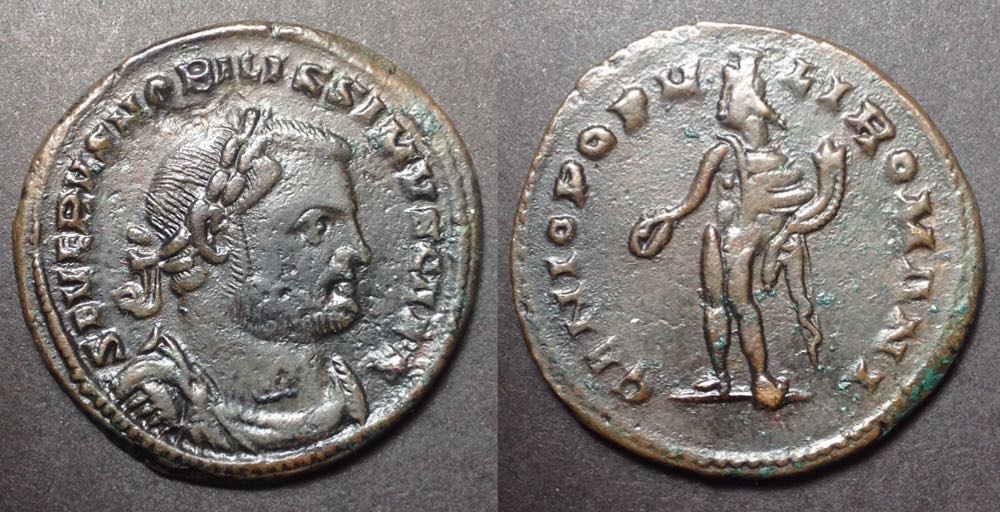
Severus II as Caesar
28-27 mm. 9.86 grams.
SEVERVS NOBILISSIMVS CAES
Bust right, laureate, draped, and cuirassed.
GENIO POPVLI ROMANI
no mintmark = London mint
RIC London 59a
Cloke and Toone 4.02.016, page 122 "1 May 305 - 26 July 306"
Maximinus II as Caesar
29-27 mm. 8.52 grams.
GAL VAL MAXIMINVS NOB C
Bust right, laureate, draped, and cuirassed.
GENIO POPVLI ROMANI
RIC London 57
Cloke and Toone 4.03.021, "1 May 305-Spring 307"

Severus II as Caesar
33-30 mm. Unusually large flan.
SEVERVS NOB C
Bust right, laureate, draped, and cuirassed.
GENIO POPVLI ROMANI
altar left at feet of Genius
✳ right
PLG in exergue
RIC Lugdunum 199a, "1 May 305 - July 306"
Sear IV 14632
(Go to the other GENIO POPVLI ROMANI coins above)
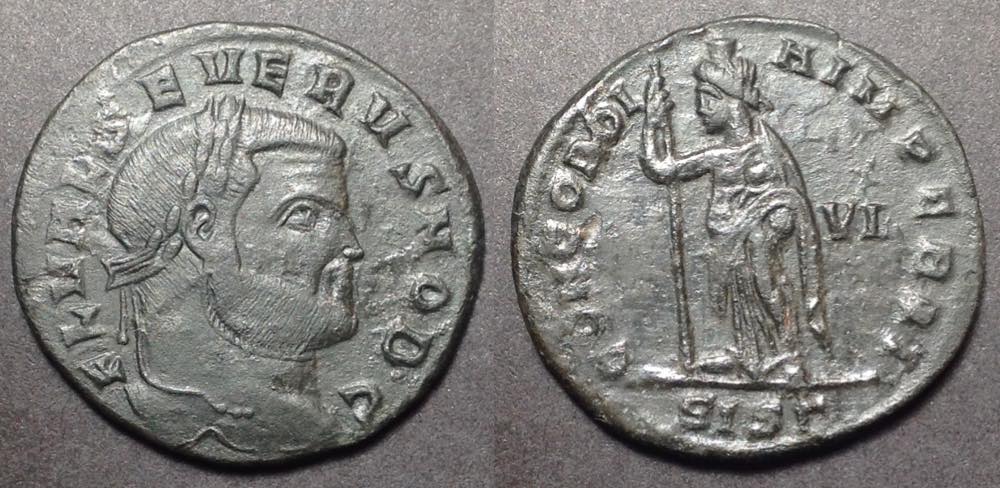
Severus II as Caesar
27-25 mm.
FL VAL SEVERVS NOB C
CONCORDIA IMPERII
VI
SISΓ in exergue
RIC Siscia 173a
(This type for Maximinus II)
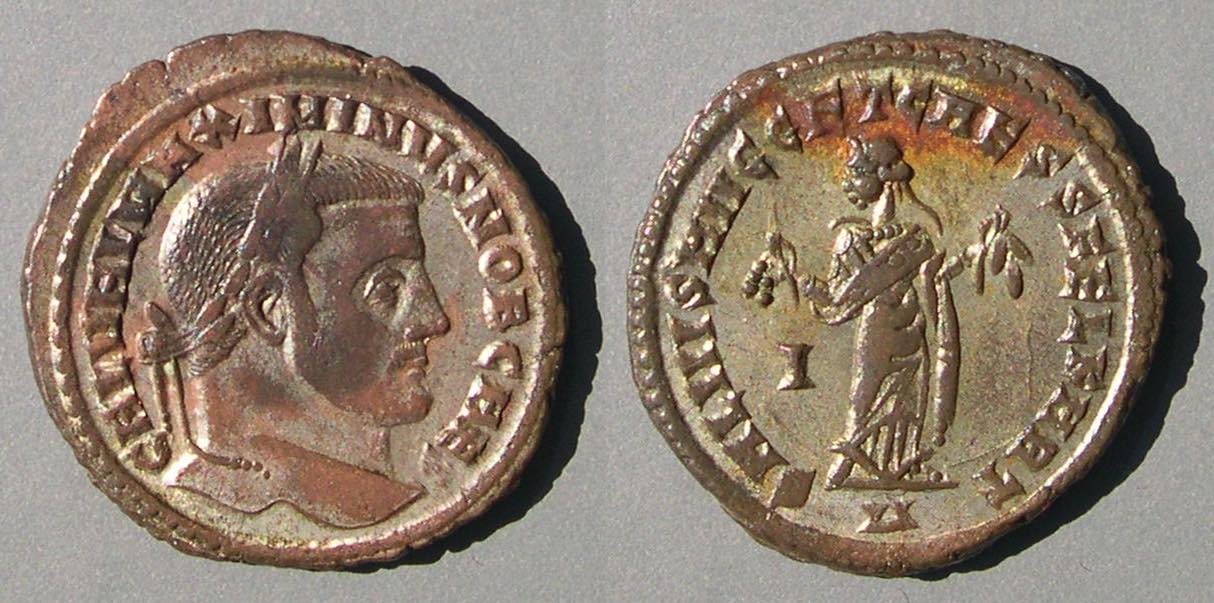
Maximinus II as Caesar
29-27 mm. 10.42 grams.
GAL VAL MAXIMINVS NOB CAES
SALVIS AVGG ET CAESS FEL KART
I
Δ in exergue
Carthage standing front, head left, holding out fruits.
RIC Carthage 40b "1 May 305-25 July 306"
(This type for Severus II)
References.
RIC Roman Imperial Coinage, volume VI. 1973. It is the essential reference for the period. Many varieties have been discovered since this book was published, but there is no easy way know more than is in this book. Many collectors use RIC solely to provide identification numbers, but it has far more interesting information than just that, including lots of history and chronology with relevant coin evidence.
Cloke and Toone, The London Mint of Constantius and Constantine. 2015. The latest word on coins of the London mint.
Failmezger, Victor. Roman Bronze Coins from Paganism to Christianity, 294-364 A.D. 2002. A complete list of types (but not mints, varieties, and RIC numbers) from the coin reform to 364, with very many color photos and short outlines of the history, with chapters on collectible types like the "fallen horseman" coins of the coin reform of 348. I love this book and use it to keep track of types.
Sear, David. Roman Coins and their Values, IV. 2011.
Zschucke, Carl-Fridrich. Die Bronze-Teilstück-Prägungen der römischen Münzstätte Trier. 1989. Small paperback. 65 pages with over 200 fractions illustrated.
Continue with a page on coins after the Second Tetrarchy, from 306-324.
Go to the page on the coins of the First Tetrarchy, 293-305.
There is a page of links to other pages on coins of the tetrarchies,
Go to the main Table of Contents of this educational site.